Marcia Thornton Jones's Blog, page 137
April 22, 2017
Spring Re-Vision by Laurie Calkhoven
There is a hard truth to be told: beforespring becomes beautiful, it is plugugly, nothing but mud and muck. I have walked in the early springthrough fields that will suck your bootsoff, a world so wet and woeful it makesyou yearn for the return of ice. But inthat muddy mess, the conditions forrebirth are being created.
I recently came across that quote by a man named Parker Palmer. If Google is to be trusted, he is the founder of the Center for Courage and Renewal in Seattle, which sounds like a wonderful place.
Depending on where you live in the world, that quote might be more appropriate for March than April, but I read it and immediately thought – what a great metaphor for revision!
Our drafts can be plug ugly. They can make us feel wet and woeful, like trying to improve them is like sinking into mud. But in those muddy messes of words and paragraphs and pages, the conditions for rebirth, for re-vision, were created. We have to trust that the seeds are there, ready to be nurtured so that they can be reborn.
I recently came across that quote by a man named Parker Palmer. If Google is to be trusted, he is the founder of the Center for Courage and Renewal in Seattle, which sounds like a wonderful place.
Depending on where you live in the world, that quote might be more appropriate for March than April, but I read it and immediately thought – what a great metaphor for revision!
Our drafts can be plug ugly. They can make us feel wet and woeful, like trying to improve them is like sinking into mud. But in those muddy messes of words and paragraphs and pages, the conditions for rebirth, for re-vision, were created. We have to trust that the seeds are there, ready to be nurtured so that they can be reborn.
Published on April 22, 2017 03:20
April 18, 2017
National Poetry Month
It was a poet who said that April is the cruelest month. But it's a lot less cruel for me this year because it's also National Poetry Month, which I'm celebrating by committing myself to write a poem each day for the thirty days of April.
I was feeling creatively stuck, and this seemed a way to get unstuck. So I joined a group of poets organized by California-based poet Molly Fisk.The way the group is organized is this. Every day Molly gives us a prompt. We write a poem on that prompt, or some other topic of our own inspiration, We share the poem on the online group bulletin board, if we so choose, and comment on each others' poems, if the spirit moves us, following the only actual rule Molly prescribes: appreciation only, no critique.
This month of daily immersion in poetry has changed my life, not only giving me an intravenous infusion of creative joy every day, but also making me feel better about everything else in my challenging personal and professional existence. Whatever else goes wrong that day, I can say at the end of it: "Guess what? I wrote a POEM today."
I learned some things about myself as a writer that are worth pondering.
1) I love writing poetry. I love reading poetry. I want to keep poetry in my life forever.
2) It is wonderful, at least once in a while, to write something just for myself, with no other goal except the sheer joy of doing of it.
3) But it's also wonderful to share these joy-born objects with a few friends - NOT for critique, NOT so that I can grow in my craft, but just to bask in their generous appreciation. The poem John Masefield wrote what might be the truest sentence about the creative process ever written: "Great art does not proceed from great criticism, but from great encouragement."
I still want to write middle-grade novels, and I still want to publish what I write, and I still cherish brilliant, insightful critique that will help me achieve that goal.
But for this wondrously non-cruel month of April, I'm pouring my creative energies into writing poems just for me, which will never be published, and for which I'm seeking only delightful tidbits of praise. Hooray for poetry!
I was feeling creatively stuck, and this seemed a way to get unstuck. So I joined a group of poets organized by California-based poet Molly Fisk.The way the group is organized is this. Every day Molly gives us a prompt. We write a poem on that prompt, or some other topic of our own inspiration, We share the poem on the online group bulletin board, if we so choose, and comment on each others' poems, if the spirit moves us, following the only actual rule Molly prescribes: appreciation only, no critique.
This month of daily immersion in poetry has changed my life, not only giving me an intravenous infusion of creative joy every day, but also making me feel better about everything else in my challenging personal and professional existence. Whatever else goes wrong that day, I can say at the end of it: "Guess what? I wrote a POEM today."
I learned some things about myself as a writer that are worth pondering.
1) I love writing poetry. I love reading poetry. I want to keep poetry in my life forever.
2) It is wonderful, at least once in a while, to write something just for myself, with no other goal except the sheer joy of doing of it.
3) But it's also wonderful to share these joy-born objects with a few friends - NOT for critique, NOT so that I can grow in my craft, but just to bask in their generous appreciation. The poem John Masefield wrote what might be the truest sentence about the creative process ever written: "Great art does not proceed from great criticism, but from great encouragement."
I still want to write middle-grade novels, and I still want to publish what I write, and I still cherish brilliant, insightful critique that will help me achieve that goal.
But for this wondrously non-cruel month of April, I'm pouring my creative energies into writing poems just for me, which will never be published, and for which I'm seeking only delightful tidbits of praise. Hooray for poetry!
Published on April 18, 2017 04:24
April 17, 2017
Four Hard Things (April Theme - Sarah Dooley)
I work with a kid who hates to try hard things because he doesn't want to fail. He's a smart guy with a ton of skills, but it's tricky to get him to develop new skills because he doesn't want to do anything that he's not already confident with.
What we do in that situation is this: we practice being wrong. Or, worse yet, being sometimes right and sometimes wrong, so we never know which one is coming. We take deep breaths. We gaze into a water bottle filled with glitter and we press our palms together. We get ourselves centered, ready and calm.
Then we try hard things until they aren't hard anymore.
Here are four hard things to practice in your weekly writing routine:
1. Skip a problem.
When you hit a snag in your writing, it's easy to get sucked into trying to fix the problem at all costs. Sometimes it feels like you can't move on until you've solved the riddle, patched the plot gap, or untangled the timeline. Something that's hard for me -- something I have to make myself practice -- is to skip over the snag and land where I know I want the story to go next -- then loop back later and connect the dots. I hate leaving things unresolved, but I have to trust that I can fix the problem later.
2. Reach out to a reader.
Post on your author account on social media. Answer an email. Send a pack of bookmarks to a school that might want to have you in to speak. Do something each week to reach out to your audience, no matter how far outside your comfort zone it might be to do so.
3. Write something for fun.
Working on a novel? Write a poem. Or a short story. Or even a bit of fan fiction. Something fun just for yourself. Sometimes we think of writing as a job and we forget how much fun it can be. Take a risk and remind yourself why you started writing in the first place!
4. Own your shortcomings.
I am a procrastinator. I am terrible at meeting deadlines. The more I try to dodge this issue, the more stressful it becomes and the worse I get at being on time. So now I know that I need to allow myself my flaws and just leave myself extra time. If the deadline is June 1, May 15 is circled on my calendar.
It's uncomfortable, trying something that's hard, but you can't learn new skills without going out on a limb. A very cool kid taught me that.
What we do in that situation is this: we practice being wrong. Or, worse yet, being sometimes right and sometimes wrong, so we never know which one is coming. We take deep breaths. We gaze into a water bottle filled with glitter and we press our palms together. We get ourselves centered, ready and calm.
Then we try hard things until they aren't hard anymore.
Here are four hard things to practice in your weekly writing routine:
1. Skip a problem.
When you hit a snag in your writing, it's easy to get sucked into trying to fix the problem at all costs. Sometimes it feels like you can't move on until you've solved the riddle, patched the plot gap, or untangled the timeline. Something that's hard for me -- something I have to make myself practice -- is to skip over the snag and land where I know I want the story to go next -- then loop back later and connect the dots. I hate leaving things unresolved, but I have to trust that I can fix the problem later.
2. Reach out to a reader.
Post on your author account on social media. Answer an email. Send a pack of bookmarks to a school that might want to have you in to speak. Do something each week to reach out to your audience, no matter how far outside your comfort zone it might be to do so.
3. Write something for fun.
Working on a novel? Write a poem. Or a short story. Or even a bit of fan fiction. Something fun just for yourself. Sometimes we think of writing as a job and we forget how much fun it can be. Take a risk and remind yourself why you started writing in the first place!
4. Own your shortcomings.
I am a procrastinator. I am terrible at meeting deadlines. The more I try to dodge this issue, the more stressful it becomes and the worse I get at being on time. So now I know that I need to allow myself my flaws and just leave myself extra time. If the deadline is June 1, May 15 is circled on my calendar.
It's uncomfortable, trying something that's hard, but you can't learn new skills without going out on a limb. A very cool kid taught me that.
Published on April 17, 2017 13:41
April 16, 2017
Four Stars by Naomi Kinsman
⭐ ⭐ ⭐ ⭐
I have to be honest, I hit a bit of a block when searching for something to write that connected with the number four.
And then, I googled quotes about the number four. Eureka!
First, a lesson relearned: When a mental path is blocked, try a window.
Second, I saw a number of posts and quotes that referenced four stars, which caused me to think about our star-filled world. We are constantly asked to rate movies, books, restaurants, and many other experiences, on a scale of one to five stars.
I nearly always give a rating of four stars.
Why four? Well, on the one hand, I'm inclined toward optimism. It takes quite a lot for me to decide something is worthy of dislike. On the other hand, I want to reserve that elusive five-star rating for the experiences that are truly over and above.
⭐ ⭐ ⭐ ⭐
We've all had the experience of having someone ask us to give them a five-star rating because if we don't, they will have their bonus docked, or they will receive some other dire consequence. We're all influenced when we see that a particular restaurant or book has received five-stars, but we don't consider that the stars are likely rather arbitrary. What influenced each person who rated the experience? Are people more likely to rate experiences that disappointed them, and if so, does this skew the data toward the negative? Or, are there many people like me, who have a knee-jerk four-star response?
Since I'm an optimist, I try to believe that with higher numbers, the responses are more accurate. Maybe a few outliers rated a podcast because they hated it, but hopefully, most of the people who chimed in responded thoughtfully.
I also think about my books, about the star averages on each title, and how important those ratings can feel to me. I wonder how arbitrary the numbers are, and what, if anything I should read into them.
⭐ ⭐ ⭐ ⭐
What tips the scales for you? What bumps a book, movie, podcast or restaurant into the five-star range? How much does a star average influence your willingness to try something new?
I have to be honest, I hit a bit of a block when searching for something to write that connected with the number four.
And then, I googled quotes about the number four. Eureka!
First, a lesson relearned: When a mental path is blocked, try a window.
Second, I saw a number of posts and quotes that referenced four stars, which caused me to think about our star-filled world. We are constantly asked to rate movies, books, restaurants, and many other experiences, on a scale of one to five stars.
I nearly always give a rating of four stars.
Why four? Well, on the one hand, I'm inclined toward optimism. It takes quite a lot for me to decide something is worthy of dislike. On the other hand, I want to reserve that elusive five-star rating for the experiences that are truly over and above.
⭐ ⭐ ⭐ ⭐
We've all had the experience of having someone ask us to give them a five-star rating because if we don't, they will have their bonus docked, or they will receive some other dire consequence. We're all influenced when we see that a particular restaurant or book has received five-stars, but we don't consider that the stars are likely rather arbitrary. What influenced each person who rated the experience? Are people more likely to rate experiences that disappointed them, and if so, does this skew the data toward the negative? Or, are there many people like me, who have a knee-jerk four-star response?
Since I'm an optimist, I try to believe that with higher numbers, the responses are more accurate. Maybe a few outliers rated a podcast because they hated it, but hopefully, most of the people who chimed in responded thoughtfully.
I also think about my books, about the star averages on each title, and how important those ratings can feel to me. I wonder how arbitrary the numbers are, and what, if anything I should read into them.
⭐ ⭐ ⭐ ⭐
What tips the scales for you? What bumps a book, movie, podcast or restaurant into the five-star range? How much does a star average influence your willingness to try something new?
Published on April 16, 2017 14:46
April 12, 2017
Just One Thing: New MG by Author Nancy Viau
Here’s a bit about how Just One Thing! (illustrated by Timothy Young) came to be:
Having raised two sons (and two daughters, but that’s beside the point), I wanted to write from a boy’s point of view. So naturally, in the beginning stages, I asked them, “What were your memories of growing up?” Their answers: hanging out with friends, the traumatic move from PA to NJ, water gun fights, bikes, soccer, gymnastics, goofing off when homework was due, school projects, road trips to South Philly to visit relatives and eat cheese steaks, and more. I also asked guys I connected with on the Blue Boards, and they chimed in with: the Booger Wall at school, whoopee cushions, playground obstacles courses, bullies, and nicknames. (I can’t find these guys on the boards anymore, but Adam, Marcus, and Ryan, if you’re reading this, I promised you a copy for helping me, so contact me.)
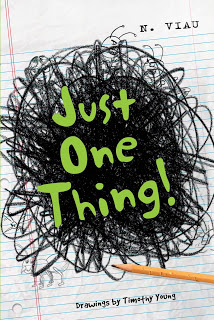
Bottom line, many of these adventures became part of Anthony Pantaloni’s quest to find one thing he does well; one thing that replaces the awful nickname he got tagged with in fifth grade, and one thing he could be known for before he moves on to middle school. We all have those things that contribute to our identity. For kids, it’s more profound and constantly changing. How many of you remember that friend who was obsessed with horses, or the jokester who made funny faces behind the teacher’s back, or an amazing athlete, or extremely talented musician?
Just One Thing! is available at bookstores and online. Oh, I almost forgot! You can doodle in the book, but of course, only if it’s your copy. And only if you promise to contemplate, what’s your one thing?
Nancy Viau no longer worries about finding her one thing for she has found quite a few things she loves, like being a mom, writing, traveling, and working as a librarian assistant. She is the author of an additional middle-grade novel, Samantha Hansen Has Rocks in Her Head. Nancy grew up in the suburbs of Philadelphia, PA and now resides in South Jersey. www.NancyViau.com/ @NancyViau1
Published on April 12, 2017 06:00
April 11, 2017
The 4-Minute Brainstorm
by Jody FeldmanOne of my most frequently asked questions: Do you ever get writer’s block?
My answer: No, because I choose not to believe it actually exists. At least for me. I can always write something. Often that starts with my 4-Minute Brainstorm.
This works best when you’re focused on one detail or one scene or one characteristic (like your character’s motivation or next action).
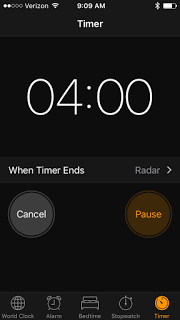 Step #1 Set a timer for 4 minutes. Why 4 minutes? Three minutes feels too rushed. Five makes you believe you have all sorts of time. Those 240 ticks are the perfect amount to force you to concentrate.
Step #1 Set a timer for 4 minutes. Why 4 minutes? Three minutes feels too rushed. Five makes you believe you have all sorts of time. Those 240 ticks are the perfect amount to force you to concentrate.
Step #2Now go! Write a LIST (not a free-form paragraph) of every idea you can think of, starting with the obvious and morphing to the absurd. If you get stuck, look around and use any object for inspiration. For example, let’s say I’m writing about Davy, and I need to know why he’s intimidated by Cheyenne. My list might look something like this.
She’s pretty.She overbearing.She acts like she’s better than everyone else.She acts like he’s not good enough.She gossips.Everyone seems to love her.She never makes a mistake.She ranked the class on a math test, and she’s not good in math.Everyone was fawning over her polka-dot purse.She always has new pictures of puppies with bows in their hair.Her pencils are always sharp.She knows more about cranberries than he does.They have the same haircut and it looks better on her.She can lift more weight in gym.She laughed when he had lettuce in his teeth. She knows some celebrities.She yelled at a teacher to shut up.She draws tattoos on people even when they don’t want them.Her yearbook picture didn’t look like a warthog.She looks like she always wears clean underwear. (Nod to Louis Sachar.)
Step #3Beep-beep! Beep-beep! Your timer goes off. You should have at least 20 ideas. Yes, 20 (though it may take some training to stifle your inner editor). Now, cross off your first 4 ideas; unless you started with a bizarre frame of mind, these ideas will be the most boring obvious. You can do better than that. Read through the rest and cross out the ones that every other writer would use. And again, read through, really contemplating how each might have a place in your story. Don’t discount the wacky ideas; even those may have some underlying truths. Highlight your favorite four.
Step #4Use one or all of them. Sometimes two or more can be combined to make one truly original idea.
It works every time. At best, you have a scene, or even part of one, that feels fresh. At worst, you have a placeholder for an idea that might come at a later time. Above all, though, you haven’t stopped writing.
My answer: No, because I choose not to believe it actually exists. At least for me. I can always write something. Often that starts with my 4-Minute Brainstorm.
This works best when you’re focused on one detail or one scene or one characteristic (like your character’s motivation or next action).
 Step #1 Set a timer for 4 minutes. Why 4 minutes? Three minutes feels too rushed. Five makes you believe you have all sorts of time. Those 240 ticks are the perfect amount to force you to concentrate.
Step #1 Set a timer for 4 minutes. Why 4 minutes? Three minutes feels too rushed. Five makes you believe you have all sorts of time. Those 240 ticks are the perfect amount to force you to concentrate. Step #2Now go! Write a LIST (not a free-form paragraph) of every idea you can think of, starting with the obvious and morphing to the absurd. If you get stuck, look around and use any object for inspiration. For example, let’s say I’m writing about Davy, and I need to know why he’s intimidated by Cheyenne. My list might look something like this.
She’s pretty.She overbearing.She acts like she’s better than everyone else.She acts like he’s not good enough.She gossips.Everyone seems to love her.She never makes a mistake.She ranked the class on a math test, and she’s not good in math.Everyone was fawning over her polka-dot purse.She always has new pictures of puppies with bows in their hair.Her pencils are always sharp.She knows more about cranberries than he does.They have the same haircut and it looks better on her.She can lift more weight in gym.She laughed when he had lettuce in his teeth. She knows some celebrities.She yelled at a teacher to shut up.She draws tattoos on people even when they don’t want them.Her yearbook picture didn’t look like a warthog.She looks like she always wears clean underwear. (Nod to Louis Sachar.)
Step #3Beep-beep! Beep-beep! Your timer goes off. You should have at least 20 ideas. Yes, 20 (though it may take some training to stifle your inner editor). Now, cross off your first 4 ideas; unless you started with a bizarre frame of mind, these ideas will be the most boring obvious. You can do better than that. Read through the rest and cross out the ones that every other writer would use. And again, read through, really contemplating how each might have a place in your story. Don’t discount the wacky ideas; even those may have some underlying truths. Highlight your favorite four.
Step #4Use one or all of them. Sometimes two or more can be combined to make one truly original idea.
It works every time. At best, you have a scene, or even part of one, that feels fresh. At worst, you have a placeholder for an idea that might come at a later time. Above all, though, you haven’t stopped writing.
Published on April 11, 2017 07:45
April 10, 2017
April Theme: Breaking Through Writer’s Block by Breaking ...
April Theme: Breaking Through Writer’s Block by Breaking the Fourth WallBy Marcia Thornton Jones
When a fictional character directly addresses the audience, it’s known as breaking the fourth wall. The term comes from theatre in which the stage represents three physical walls and the fourth being the invisible barrier between the actors and the audience. Actors typically perform as if they cannot see past the imaginary wall to the audience. When an actor does look past the fourth wall to acknowledge the audience, it’s known as breaking the fourth wall. Examples in which breaking the fourth wall is featured include the movie FERRIS BUELLER’S DAY OFF and the television series, THE OFFICE. Books like the SERIES OF UNFORTUNATE EVENTS also break the fourth wall by directly addressing the readers.
I’ve never allowed my characters to break the fourth wall, but in celebration of April, the fourth month of the year, I thought I might give it a try. The next time I hit a stumbling block while writing, I’m going to let my character break through the wall—the fourth wall—by turning around and explaining to me the following four things. How she feels about the scene, her situation, and herselfWhat she knows that I don’t knowWhy she believes the scene isn’t workingHow she thinks the scene should be written
I won’t leave these character explanations in the story, but maybe, just maybe, allowing my character to break the fourth wall will help me get past the walls that are blocking my forward writing progress!
When a fictional character directly addresses the audience, it’s known as breaking the fourth wall. The term comes from theatre in which the stage represents three physical walls and the fourth being the invisible barrier between the actors and the audience. Actors typically perform as if they cannot see past the imaginary wall to the audience. When an actor does look past the fourth wall to acknowledge the audience, it’s known as breaking the fourth wall. Examples in which breaking the fourth wall is featured include the movie FERRIS BUELLER’S DAY OFF and the television series, THE OFFICE. Books like the SERIES OF UNFORTUNATE EVENTS also break the fourth wall by directly addressing the readers.
I’ve never allowed my characters to break the fourth wall, but in celebration of April, the fourth month of the year, I thought I might give it a try. The next time I hit a stumbling block while writing, I’m going to let my character break through the wall—the fourth wall—by turning around and explaining to me the following four things. How she feels about the scene, her situation, and herselfWhat she knows that I don’t knowWhy she believes the scene isn’t workingHow she thinks the scene should be written
I won’t leave these character explanations in the story, but maybe, just maybe, allowing my character to break the fourth wall will help me get past the walls that are blocking my forward writing progress!
Published on April 10, 2017 13:49
April 8, 2017
Thinking about THE SECRET GARDEN -- Jane Kelley
Spring is coming! I have raked a few dead leaves and uncovered miracles. Peonies, bluebells, iris, rhubarb are all poking their heads up from the soil.

I think of one of my favorite books -- THE SECRET GARDEN by Frances Hodgson Burnett. I loved it as a child because I felt exactly like Mary -- misguided and misunderstood. But now I have a new appreciation for what she asks of her uncle, the owner of the estate.
"Might I," quavered Mary, "might I have a bit of earth?"
Haven't I asked exactly the same thing of the world? Might I have a bit of soil in which to grow an idea? Of space to create something? And might it be mine and mine alone? For if the garden remains secret, it can, by patient work, be transformed before other more critical eyes are upon it.
And the secret garden bloomed and bloomed and every morning revealed new miracles.
Yes, well, maybe there aren't miracles in my garden EVERY morning. Except this one -- that there is another day in which to do our best in whatever garden we have. Weed out the thistles. Tend to the roses. Pause to appreciate the birds.
Magic is always pushing and drawing and making things out of nothing. Everything is made out of magic, leaves and trees, flowers and birds, badgers and foxes and squirrels and people. So it must be all around us. In this garden -- in all the places.
The earth spins; we angle toward the sun. The days grow longer. Spring returns. Intellectually I understand the reason for all this, and yet it does seem like magic.
So do books. As Katherine Paterson said, "Reading can be a road to freedom or a key to a secret garden, which, if tended, will transform all of life."
The gate is open. Walk in.


I think of one of my favorite books -- THE SECRET GARDEN by Frances Hodgson Burnett. I loved it as a child because I felt exactly like Mary -- misguided and misunderstood. But now I have a new appreciation for what she asks of her uncle, the owner of the estate.
"Might I," quavered Mary, "might I have a bit of earth?"
Haven't I asked exactly the same thing of the world? Might I have a bit of soil in which to grow an idea? Of space to create something? And might it be mine and mine alone? For if the garden remains secret, it can, by patient work, be transformed before other more critical eyes are upon it.
And the secret garden bloomed and bloomed and every morning revealed new miracles.
Yes, well, maybe there aren't miracles in my garden EVERY morning. Except this one -- that there is another day in which to do our best in whatever garden we have. Weed out the thistles. Tend to the roses. Pause to appreciate the birds.
Magic is always pushing and drawing and making things out of nothing. Everything is made out of magic, leaves and trees, flowers and birds, badgers and foxes and squirrels and people. So it must be all around us. In this garden -- in all the places.
The earth spins; we angle toward the sun. The days grow longer. Spring returns. Intellectually I understand the reason for all this, and yet it does seem like magic.
So do books. As Katherine Paterson said, "Reading can be a road to freedom or a key to a secret garden, which, if tended, will transform all of life."
The gate is open. Walk in.

Published on April 08, 2017 03:00
April 5, 2017
It's Raining Words by Deborah Lytton: April Theme
We have had a lot of rain in Southern California this year. A lot of rain! But when I am writing, I no longer hear the patter of raindrops on the roof or the low rumble of thunder. I hear words.
Confession: I love words. Big words and small words and words I don't even know yet. Words are the basis of our work as writers and they are our most valuable tool besides our imaginations.
The right words placed in the exact right order can take a reader from joy to fear to sorrow. Kate DiCamillo uses sparse prose to tell her stories. And it is the simplicity of her sentence structure that gives her stories their complexity. I love all her books, but my absolute favorite is The Miraculous Journey of Edward Tulane .
 In sentences of four words or less, Ms. DiCamillo wraps a story around the reader's heart where it will remain forever.
In sentences of four words or less, Ms. DiCamillo wraps a story around the reader's heart where it will remain forever.
"I'm broken. My heart is broken. Help me."
The Miraculous Journey of Edward Tulane, Page 149.
"The door closed. The bell tinkled.
And Edward was alone."
The Miraculous Journey of Edward Tulane, Page 177.
Every word has an important role to play in spare prose. If it isn't essential, then it doesn't belong. I think it takes a great deal of discipline to parse sentences down to their barest form. So today, as a writing exercise, challenge yourself to write a scene using sentences of five words or less. See what you can do with the perfect four words.
Happy writing!
Confession: I love words. Big words and small words and words I don't even know yet. Words are the basis of our work as writers and they are our most valuable tool besides our imaginations.
The right words placed in the exact right order can take a reader from joy to fear to sorrow. Kate DiCamillo uses sparse prose to tell her stories. And it is the simplicity of her sentence structure that gives her stories their complexity. I love all her books, but my absolute favorite is The Miraculous Journey of Edward Tulane .
 In sentences of four words or less, Ms. DiCamillo wraps a story around the reader's heart where it will remain forever.
In sentences of four words or less, Ms. DiCamillo wraps a story around the reader's heart where it will remain forever."I'm broken. My heart is broken. Help me."
The Miraculous Journey of Edward Tulane, Page 149.
"The door closed. The bell tinkled.
And Edward was alone."
The Miraculous Journey of Edward Tulane, Page 177.
Every word has an important role to play in spare prose. If it isn't essential, then it doesn't belong. I think it takes a great deal of discipline to parse sentences down to their barest form. So today, as a writing exercise, challenge yourself to write a scene using sentences of five words or less. See what you can do with the perfect four words.
Happy writing!
Published on April 05, 2017 11:25
April 3, 2017
4 Writing Craft Books that Changed My Life
Like many of you, I'm a self-taught writer. My degrees are in a whole different field, and I never took a writing class while I was in college. So I have gotten my education through conferences and critique groups and my agent/editors -- and books. Here are four that revolutionized my writing life at the time I found them.
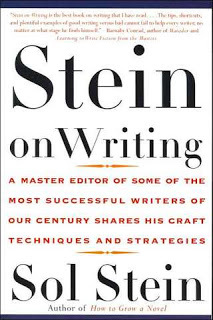 1. STEIN ON WRITING by Sol Stein
1. STEIN ON WRITING by Sol Stein
I found this book when I was revising with an editor my first novel for children: LEAVING GEE'S BEND. This book taught me about suspense, and how you can strengthen your characters by giving them dialogue tags. In the chapter devoted to "Show-Don't Tell," I finally understood exactly what that means, and how to do it in my own writing.
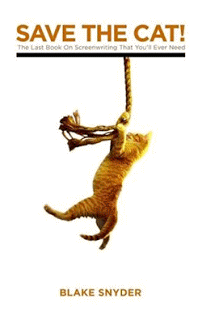
2. SAVE THE CAT by Blake Snyder
This book is for screenwriters, so it is very visual. It taught me to plot my own novels in scenes. And it gave me perhaps the greatest outlining tool ever known: The Beat Sheet. I use this on every project now. It's the most basic way to help you know where your story starts, and where you're headed.
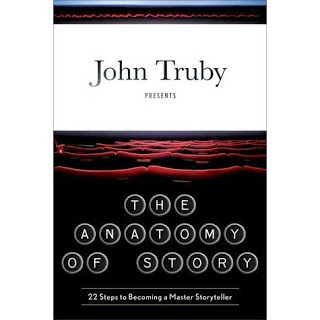 3. THE ANATOMY OF STORY by John Truby
3. THE ANATOMY OF STORY by John Truby
I found this book at a time when I was really struggling. I had written a number of novels, and none of them had sold. I was questioning everything about my writing life. When I got to the pages early in the book about premise, and how to "write a book that will change your life," I might have wept with gratitude. These were the words I needed to hear. This was the direction I so desperately needed. Since then I have written and sold at least five new books!
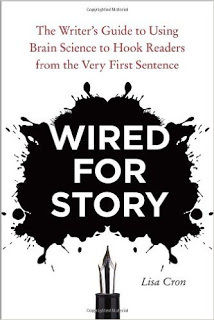 4. WIRED FOR STORY by Lisa Cron
4. WIRED FOR STORY by Lisa Cron
This book is my most recent find. Some important things clicked for me when I was reading this book -- particularly about stories needing to be about the character - that the CHARACTER must drive the plot. And also about how the reader doesn't care much about "well written." The reader wants intrigue! It suggests (among so many other things!) that we shift our focus a bit, and start by letting the reader know right from the start that something's rotten in the state of Denmark. Most importantly, this book has given me the courage to give that manuscript that I've written oh about 978 times another go.
Has there been a life-changing writing craft book in your life? If so, please share in comments!
p.s. Happy National Poetry Month! Join the celebration.
-----------------
IRENE LATHAM is the author of more than a dozen current and forthcoming books, including two novels for children Leaving Gee's Bendand Don't Feed the Boy. Winner of the 2016 ILA Lee Bennett Hopkins Promising Poet Award, her poetry books for children include Dear Wandering Wildebeest, When the Sun Shines on Antarctica, Fresh Delicious and Can I Touch Your Hair? (co-written with Charles Waters). Irene lives in Birmingham, Alabama with her family where she does her best to “live her poem” every single day by laughing, playing the cello, and walking in the woods. irenelatham.com
 1. STEIN ON WRITING by Sol Stein
1. STEIN ON WRITING by Sol SteinI found this book when I was revising with an editor my first novel for children: LEAVING GEE'S BEND. This book taught me about suspense, and how you can strengthen your characters by giving them dialogue tags. In the chapter devoted to "Show-Don't Tell," I finally understood exactly what that means, and how to do it in my own writing.

2. SAVE THE CAT by Blake Snyder
This book is for screenwriters, so it is very visual. It taught me to plot my own novels in scenes. And it gave me perhaps the greatest outlining tool ever known: The Beat Sheet. I use this on every project now. It's the most basic way to help you know where your story starts, and where you're headed.
 3. THE ANATOMY OF STORY by John Truby
3. THE ANATOMY OF STORY by John TrubyI found this book at a time when I was really struggling. I had written a number of novels, and none of them had sold. I was questioning everything about my writing life. When I got to the pages early in the book about premise, and how to "write a book that will change your life," I might have wept with gratitude. These were the words I needed to hear. This was the direction I so desperately needed. Since then I have written and sold at least five new books!
 4. WIRED FOR STORY by Lisa Cron
4. WIRED FOR STORY by Lisa CronThis book is my most recent find. Some important things clicked for me when I was reading this book -- particularly about stories needing to be about the character - that the CHARACTER must drive the plot. And also about how the reader doesn't care much about "well written." The reader wants intrigue! It suggests (among so many other things!) that we shift our focus a bit, and start by letting the reader know right from the start that something's rotten in the state of Denmark. Most importantly, this book has given me the courage to give that manuscript that I've written oh about 978 times another go.
Has there been a life-changing writing craft book in your life? If so, please share in comments!
p.s. Happy National Poetry Month! Join the celebration.
-----------------
IRENE LATHAM is the author of more than a dozen current and forthcoming books, including two novels for children Leaving Gee's Bendand Don't Feed the Boy. Winner of the 2016 ILA Lee Bennett Hopkins Promising Poet Award, her poetry books for children include Dear Wandering Wildebeest, When the Sun Shines on Antarctica, Fresh Delicious and Can I Touch Your Hair? (co-written with Charles Waters). Irene lives in Birmingham, Alabama with her family where she does her best to “live her poem” every single day by laughing, playing the cello, and walking in the woods. irenelatham.com
Published on April 03, 2017 03:30



